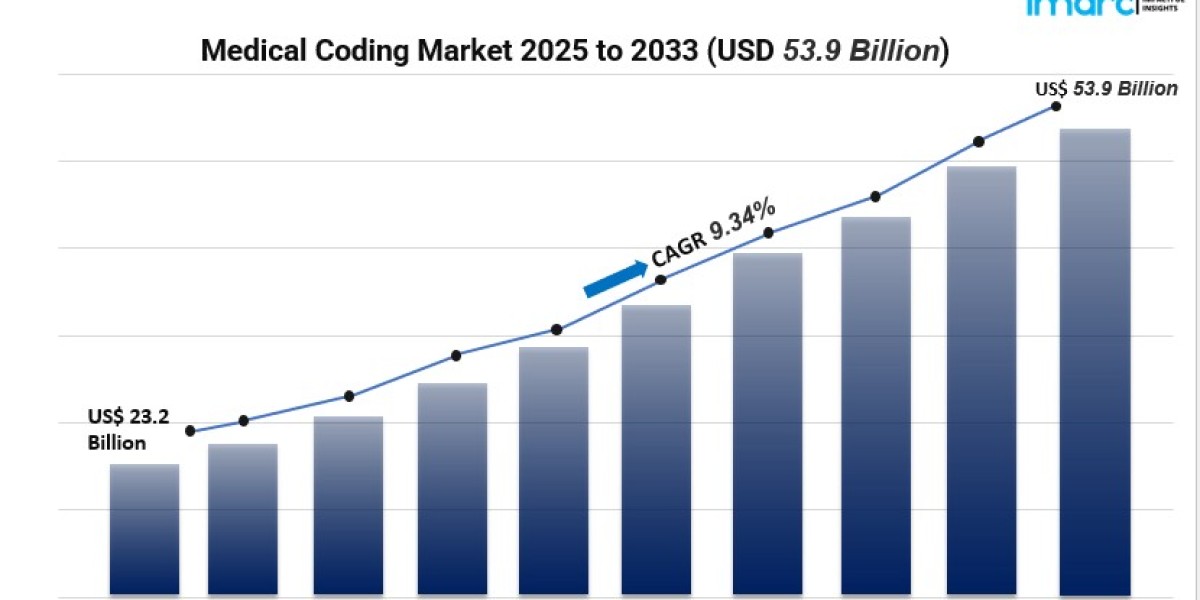Market Overview
The global medical coding market is gearing up for some serious growth, and it’s all thanks to the rising use of electronic health records (EHRs), the push for standardized healthcare data, and supportive government initiatives. With a valuation of USD 23.2 billion in 2024, it’s expected to skyrocket to USD 53.9 billion by 2033, boasting a compound annual growth rate (CAGR) of 9.34%. This impressive growth is largely driven by technological advancements that improve coding accuracy and efficiency, along with a growing trend of outsourcing as a smart, cost-effective strategy for healthcare providers.
Study Assumption Years
- Base Year: 2024
- Historical Years: 2019–2024
- Forecast Years: 2025–2033
Medical Coding Market Key Takeaways
- The global medical coding market is projected to grow from USD 23.2 billion in 2024 to USD 53.9 billion by 2033, at a CAGR of 9.34%.
- North America leads the market, attributed to its advanced healthcare infrastructure and high compliance requirements.
- The integration of AI and machine learning technologies is enhancing coding accuracy and efficiency.
- There is a global push for standardized coding practices through international classification systems.
- Outsourcing of coding tasks is increasing, particularly in regions like India and the Philippines.
- The demand for skilled medical coders is rising, creating global job opportunities.
- The shift towards EHRs and the need for standardized data are key growth drivers in the market.
Market Growth Factors
Technological Advancements in Medical Coding
The medical coding landscape is experiencing a rapid transformation, fueled by innovative technologies. The integration of artificial intelligence (AI) and machine learning (ML) is changing the game for traditional coding methods by automating complex tasks, cutting down on errors, and significantly ramping up efficiency. These technologies enable quick analysis of massive amounts of clinical data, allowing healthcare professionals to concentrate more on patient care instead of getting bogged down in tedious manual data entry. Plus, the widespread use of electronic health records (EHRs) makes data exchange smoother, further boosting the speed and accuracy of coding. As the volume of patient data keeps climbing, these advancements are essential for ensuring accurate billing, meeting regulatory standards, and streamlining healthcare operations.
Regulatory Influence and Standardization
The growth of the medical coding industry is heavily shaped by strict health regulations and the demand for standardized, reliable data. The global adoption of international classification systems, like the International Classification of Diseases (ICD) and Current Procedural Terminology (CPT), is crucial for maintaining consistency and accuracy in medical coding. Health authorities and governments around the world are promoting these unified systems to enhance healthcare quality and ensure precise data exchange across borders. These regulatory demands are driving the development of advanced coding technologies.
Rising Demand for Outsourcing and Cost-Efficient Solutions
The rising trend of outsourcing medical coding services is a key driver of market growth. Healthcare providers are increasingly partnering with third-party vendors, especially in countries like India and the Philippines, where there’s a rich pool of skilled professionals and lower operational costs. By outsourcing, healthcare organizations can save money, enhance operational efficiency, and keep up with the ever-evolving regulations. This approach allows hospitals and diagnostic centers to concentrate on their primary clinical responsibilities while ensuring that coding and billing processes remain accurate and efficient, all without compromising the quality of care. It’s expected that this trend will continue to gain traction, further boosting the medical coding market.
Request for a sample copy of this report: https://www.imarcgroup.com/medical-coding-market/requestsample
Market Segmentation
Breakup by Component
- In-house: Medical coding services managed internally by healthcare organizations, allowing for direct control over coding processes and immediate integration with existing systems.
- Outsourced: Medical coding services contracted to external providers, offering cost savings and access to specialized expertise.
Breakup by Classification System
- International Classification of Diseases (ICD): A globally recognized system for coding various diseases and health conditions, facilitating international data comparison and healthcare planning.
- Healthcare Common Procedure Code System (HCPCS): A standardized coding system used primarily in the United States for billing medical procedures and services.
Breakup by End User
- Hospitals: Large healthcare facilities that require extensive medical coding for a wide range of services and procedures.
- Diagnostic Centers: Facilities specializing in diagnostic services, necessitating precise coding for accurate billing and record-keeping.
- Others: Includes various healthcare providers such as clinics and outpatient centers that utilize medical coding for operational efficiency.
Breakup by Region
• North America (United States, Canada)
• Asia Pacific (China, Japan, India, South Korea, Australia, Indonesia, Others)
• Europe (Germany, France, United Kingdom, Italy, Spain, Russia, Others)
• Latin America (Brazil, Mexico, Others)
• Middle East and Africa
Regional Insights
North America is leading the global market for medical coding, thanks to its advanced healthcare infrastructure, strict regulatory environment, and quick adoption of cutting-edge technologies like AI and electronic health records (EHRs). Healthcare organizations in this region are making substantial investments in top-notch medical coding systems to improve regulatory compliance, minimize billing errors, and streamline healthcare management.
Recent Developments & News
The healthcare coding industry is experiencing a significant transformation, fueled by advancements in AI and machine learning. These technologies are revolutionizing the field by automating coding processes, reducing errors, and enhancing efficiency. Additionally, the adoption of global standards like ICD-11 and the increasing integration of electronic health records (EHRs) are driving the demand for more sophisticated coding systems and highly skilled professionals.
Key Players
- 3M Company
- Access Healthcare
- Aviacode Inc. (GeBBS Healthcare Solutions Inc.)
- Dolbey Systems Inc.
- Global Healthcare Resource
- Maxim Healthcare Staffing
- Medical Record Associates Inc.
- Nuance Communications Inc. (Microsoft Corporation)
- Optum Inc. (UnitedHealth Group Incorporated)
- Outsource Strategies International
- The Coding Network LLC.
Ask Analyst for Customization: https://www.imarcgroup.com/request?type=report&id=5137&flag=C
If you require any specific information that is not covered currently within the scope of the report, we will provide the same as a part of the customization.
About Us:
IMARC Group is a global management consulting firm that helps the world’s most ambitious changemakers to create a lasting impact. The company provides a comprehensive suite of market entry and expansion services. IMARC offerings include a thorough market assessment, feasibility studies, company incorporation assistance, factory setup support, regulatory approvals and licensing navigation, branding, marketing and sales strategies, competitive landscape, and benchmarking analyses, pricing and cost research, and procurement research.
Contact Us:
IMARC Group
134 N 4th St. Brooklyn, NY 11249, USA
Email: sales@imarcgroup.com
Tel No: +1-631-791-1145







